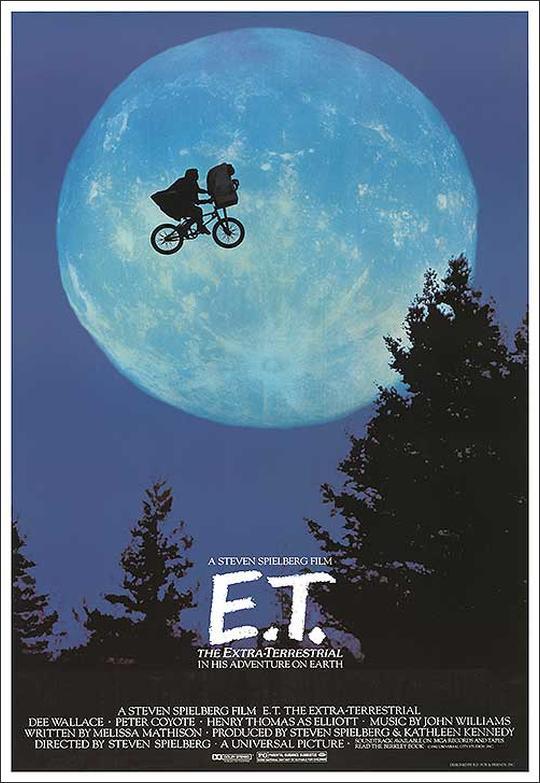Tagline: His Adventure On Earth.
E.T. The Extra-Terrestrial movie storyline. While visiting the Earth at night, a group of alien botanists is discovered and disturbed by an approaching human task force. Because of the more than hasty take-off, one of the visitors is left behind. The little alien finds himself all alone on a very strange planet. Fortunately, the extra-terrestrial soon finds a friend and emotional companion in 10 year-old Elliot, a lonely boy whose parents have separated.
While E.T. slowly gets acquainted with Elliot’s older brother Michael, his sister Gertie, and the customs of Earth, members of the task force work day and night to track down the whereabouts of Earth’s first visitor from outer space. The wish to go home again is strong in E.T., and after being able to communicate with Elliot and the others, E.T. starts building an improvised device to send a message home for his people to come and pick him up. But before long, E.T. gets seriously sick, and because of his special connection to Elliot, the young boy suffers, too. The situation gets critical when the task force finally intervenes. By then, all help may already be too late, and there’s no alien spaceship in sight.
E.T. The Extra-Terrestrial (1982) is the popular myth magical fantasy film. Its budget is estimated at 10 million dollars was recovered easily when it became one of the film’s box office champion of all time. Steven Spielberg is very personal, warm masterpiece of science fiction (with special effects produced by George Lucas Industrial Light and Magic Company) has been warmly accepted by the public of the film for its depiction of love between a young suburban boy and a caring father lost and homesick visitor (probably an adult) from another planet who is wrongly abandoned and orphaned land – three million light years from home.
The film’s themes are discovered, rescue and escape, rather like the myth of Peter Pan (included in the film). John Alvin’s poster for the film with light, heavenly finger also has a religious theme, recalling the creation of Michelangelo’s “painting of Adam on the Sistine Chapel ceiling. And the story of the death and resurrection posted parallels with the biblical story. One of the first titles of the film work was a Boy’s Life.
Much of the film was deliberately shot from a lower angle camera – to the point of a child-of-view manipulatively encourage young viewers to identify with the characters, to simulate how overwhelming and threatening adults turn to children (from the knees or waist down), and force the adult viewers to relive their childhood. He also filmed in sequence, so that the scene of departure his conclusion should contain a sincere emotion.
Spielberg has been working simultaneously on two suburban-based stories: ET (Director) and Poltergeist (1982) (as producer) – but while one was a fantasy, the other is a story of nightmarish horror. This story of a creature beloved foreign to the opposite side of a movie later, Spielberg, War of the Worlds (2005), with destruction of foreign invaders.
[His twenty years of existence in 2002 was celebrated with the restoration of the film and re-release – a slightly longer version with additional scenes deleted from the original (eg, bathtub scene), sound effects and digital re-mastering to improve ET reactions to the face, spaceship, flying AND from the faceless men through the forest, and two sequences of bike theft. Guns used by officers of 1982 have been digitally excised or replaced by walkie-talkies, as was the line: “No guns – they are children.” A reference to a “terrorist” has been replaced by the word “hippie.” These changes have followed the trend of the times – slightly modified films at their new edition, as was also done with The Exorcist (1973) and The Exorcist: The Version You’ve Never Seen (2000), Apocalypse Now (1979) and Apocalypse Now Redux (2001) and Star Wars (1977) and Star Wars: The Special Edition (1997).]
In his nine Academy Awards nominations, he received four Oscars: Best Sound Editing Effects, Best Visual Effects, Best Music (John Williams) and Best Sound. The film lost in the following categories: Best Picture (it lost to Gandhi), Best Director, Best Cinematography, Best Editing and Best Screenplay (Melissa Mathison, who was later married to star Harrison Ford – their scene in the film as ‘head teacher and the nurse was cut). This film, sometimes criticized as over-rated, was the biggest blockbuster Spielberg this time.
Although the film was considered by some to be a religious allegory or parable, the film seeks to better identify with many experiences of childhood disorders, broken families with one parent and any positive role models, a solo performance , disenfranchised boy lacks emotional support a fierce boy for so lost, stray creature or PET (also “broken” family), the need for friendship, evil adult world and the perils Child, miraculous healing, fulfillment of desire, courage, transcendence, and nostalgia. The tale is a variation of The Wizard of Oz (1939) in this story, three young children to help a creature of space to return to his home. It was also considered a “child version” of events Spielberg own a third type (1977), with a stranger who is instantly established as a friendly creature. Award-winning film music score by John Williams (who wrote the scores for Spielberg’s previous four films) Improvement of the outbreak, the sentimental emotions of the film.
E.T. the Extra-Terrestrial (1982)
Directed by: Steven Spielberg
Starring: Henry Thomas, Drew Barrymore, Peter Coyote, Dee Wallace, Sean Frye, Erika Eleniak, David M. O’Dell, Richard Swingler, Frank Toth, Robert Barton, Michael Darrell, David Berkson
Screenplay by: Melissa Mathison
Production Design by: James D. Bissell
Cinematography by: Allen Daviau
Film Editing by: Carol Littleton
Set Decoration by: Jackie Carr
Music by: John Williams
MPAA Rating: PG for language and mild thematic elements.
Distributed by: Universal Pictures
Release Date: June 11, 1982
Views: 173








